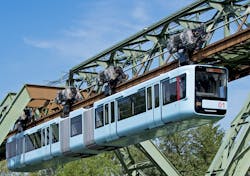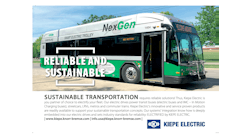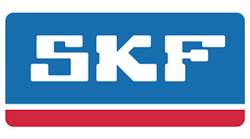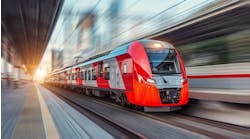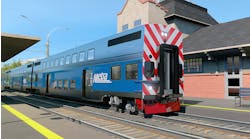Wuppertal Suspension Railway Operates More Quietly Thanks to SKF Lubrication System
The suspension railway is Wuppertal’s world-famous landmark, which has been carrying passengers across the whole city since 1901 at up to 12 meters above the ground. This means that it often passes very close to residential buildings, which is why its operator WSW (Wuppertaler Stadtwerke) wants it to operate particularly quietly. To achieve this, its subsidiary WSW mobil is deploying an innovative solution from SKF: the EasyRail Airless wheel flange lubrication system. This system reduces friction between the wheel flange and rail edge, thereby cutting noise emissions considerably.
The suspension monorail runs along a continuous steel rail in one direction, turning at the ends of the line in a loop. The cars are suspended below from their bogies. The railway can take bends with radii from 120 m, reaching a maximum speed of 60 kilometres/hour, making it considerably faster than a tram, for instance. The drive units running on the rail comprise pairs of wheels aligned behind each other. Unlike traditional rail vehicles, the suspension railway’s wheels have two wheel flanges. The wheels are also fitted with special sound absorbers to reduce the noise.
The fact that the designers of this special rail solution “looked to the heavens” for inspiration was due to the cramped space conditions on the ground. Already by the end of the 19th century, Wuppertal’s city centre was very densely built-up. Therefore, the only place which could accommodate public transport was above the river that gave the city its name. The enthusiasm for technology prevalent at that time, along with the spirit of optimism in the steel construction sector finally resulted in this ambitious project being carried out. Nowadays, the railway runs along a 13.3-kilometre route, 10 of which are directly above the river. During rush hour, 22 cars run, with three vehicles every 10 minutes. The support framework comprises 468 angled pillars, with the bridge sections supporting the track integrated into them.
Technical Facelift
The city’s favorite “old lady” is currently right in the midst of a “facelift.” “We have extensively renovated the framework during the last 20 years. We are now gradually modernizing the entire vehicle range,” explained Thomas Kaulfuss, the suspension railway’s technical operations manager. State-of-the-art cars are being used, along with an innovative radio-controlled train safety system, like the one used on the TGVs in France. But the technical specifications also mention the use of an efficient wheel flange lubrication system. “We operate in a very confined area of the city. Our aim is to use a green solution that will be environmentally-friendly and keep the level of noise disturbing residents to a minimum,” added Kaulfuss.
It didn’t take the railway specialist long to find a suitable partner. An older car had an SKF wheel flange lubrication system operating in it already for seven years. It was initially used, on a trial basis, to replace an old system powered by compressed air. A control unit with a sensor was introduced to replace a mercury switch which produced inaccurate doses. “This was a huge leap forward in our view. The system responded to speed and travelling around bends. With the new vehicles, we could program them so that the wheel flange is lubricated at any position along the route,” said Rolf Barnat enthusiastically, a supervisor in the suspension railway vehicle workshop.
This paved the way for the updated version of the SKF solution also to be deployed in the new cars. At the moment, the solution is already fitted in two vehicles, with test runs already carried out successfully, aimed at fine-tuning the settings. By the end of the year, the new cars will then be permanently running through Wuppertal.
Electromagnetic Instead of Pneumatic Operation
The SKF EasyRail Airless wheel flange lubrication system is designed so that the lubricant is supplied from a container pump to the electromagnetic dosing pump via a loop. The electromagnetic pump applies a predefined quantity of lubricant on the wheel flange without using compressed air. This “pump-nozzle unit” is equipped with a heating system, which helps ensure the reliable delivery of lubricant even when it is extremely cold.
“In Wuppertal we use PER electromagnetic pumps with two nozzles and a KFG container pump with a 2-kg capacity. The PER pump applies the grease to the wheel flange in doses of 40 cubic millimetres per nozzle and stroke in less than 0.5 seconds,” explains Tobias Weber, Account Manager Railway in the SKF Lubrication Business Unit. Weber is still in constant touch with WSW mobil, providing support in making those last fine adjustments.
The control unit of SKF's solution - a system of the LCG2 type — is equipped with a curve sensor. It supports an economical, environmentally friendly use of lubricant. On the Wuppertal suspension railway the SKF system is fitted, to save space, on the first bogie. As compressed air is no longer used, there is no point in having a compressor, as the old models did. This saves not only space but also costs, reducing the amount of cabling required. “The system’s sensitivity is controlled electronically. Users can set the curve sensor to their individual requirements and determine exactly when it will spray,” added Tobias Weber.
The practice runs using the new cars built by Vossloh-Kiepe have produced totally positive results. “We’ve had good experiences. The system is doing a completely reliable job,” says Thomas Kaulfuss. The system used in the existing rolling stock has already produced good lubrication results. Compared to the pneumatic version, the SKF system ensures far less noise is generated when travelling around bends. “This gave SKF a crucial edge. The experts have already come to see us and we’ve seen that this version works. This has made our job considerably easier when looking for a suitable solution for the new cars,” said Kaulfuss, explaining the decision-making process.
Less Produces More
Kaulfuss also sees advantages in the system’s technical design. “As we’ve stopped using compressed air and a compressor is no longer required, we don’t have so many components on the vehicle. This reduces the weight. Another benefit is that it makes installation easier because we have less cables and pipes to lay,” he added. One important issue has been dose adjustment. The control unit with a sensor resolves this task without any problem. It responds precisely to speed and travelling around bends. “The control facility via the operating system gives us the chance to respond at any time to conditions which are changing all the time,” said Kaulfuss.
Kaulfuss described the cooperation with SKF’s experts as excellent. The wheel flange lubrication system had to be adapted to the special requirements of the Wuppertal suspension railway. “SKF was already there on site, integrated the components, and performed the adjustments. It was a great team effort,” says the operations manager. From a technical perspective, EasyRail Airless offers a load of features “that we’re still gradually getting to grips with”. Kaulfuss is confident that the project will be a success. “We’ll achieve our objective of keeping road noise to a minimum.”
